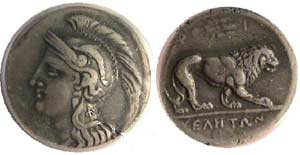Monday, August 30, 2010
The Mausoleum of the First Emperor of the Qin Dynasty and Terracotta Warriors and Horses
The Mausoleum of the First Emperor of the Qin Dynasty (221 BC-206 BC), who successfully defeated all rival ducal states and unified China by establishing the first centralized feudal dynasty, is located at the northern foot of Lishan Hill in Lintong, Shaanxi Province. It is the largest mausoleum ever discovered in the world.
The mausoleum covers a total of 2.18 million square meters, with the tomb itself covering 220,000 square meters. The tomb was designed to be 166 meters high, but years of weathering and damage have reduced this to 76 meters. The bottom of the tomb measures 485 meters by 515 meters.
The mausoleum originally consisted of inner and outer sections. The outer section had a circumference of 6,294 meters. In addition, an underground palace, 450 meters long from south to north and 390 meters wide from east to west and covering more than 180,000 square meters, has been discovered. According to Records of the Historian written over 2,000 years ago by Sima Qian, the construction of the grand project involved 700,000 laborers and took 36 years to be completed.
To date, the tomb of the Emperor Qin has not been excavated. But his buried terracotta army unearthed nearby has already stunned the world and has been called the “eighth wonder of the world”. They are the largest pottery figurine group ever unearthed in China. So far, three pits containing such figurines have been excavated. They cover a total area of 20,000 square meters. Some 8,000 life-sized warriors demonstrate a powerful military array under the rule of the First Emperor of the Qin Dynasty, 2,200 years ago.
Pit One, first discovered in 1974, measures 230 meters long and 62 meters wide, covering over 14,000 square meters. It contains more than 6,000 terracotta warriors, which, with their individual features and facial expressions, line up in battle-readiness, creating an awe-inspiring effect. The pit also buried a large number of chariots, weapons and other precious relics, of which some 10,000 metal weapons were unearthed. An unearthed bronze horse-driven chariot is the largest bronze ware ever found in the world.
The mausoleum along with the underground army entered the list of world cultural heritage sites in 1987.
The Emperor Qin's Terra-cotta Museum
Sunday, August 29, 2010
Ancient Greek Coins
The minting of coins spread rapidly from Lydia to the city states of ancient Greece. Around 600 BC , the island of Aegina produced what are believed to be the first Greek coins. These coins were known as silver drachmae and obols and depicted a turtle on the reverse, the symbol of Aegina.
The nearby Greek city state of Cornith soon followed Aegina and produced drachmae coins with the legendary figure of the winged horse Pegasus on the reverse.
The largest of the Greek city states was Athens which around 610 BC began producing very artistic coins often featuring an amphora or wine vessel design.
Alexander the Great (336-323 B.C.) established the practice of coinage throughout the Hellenic empires. His successors introduced portraits as a regular feature of their coinage designs thereby recording for posterity many images of ancient kings and rulers.
The nearby Greek city state of Cornith soon followed Aegina and produced drachmae coins with the legendary figure of the winged horse Pegasus on the reverse.
The largest of the Greek city states was Athens which around 610 BC began producing very artistic coins often featuring an amphora or wine vessel design.
Alexander the Great (336-323 B.C.) established the practice of coinage throughout the Hellenic empires. His successors introduced portraits as a regular feature of their coinage designs thereby recording for posterity many images of ancient kings and rulers.
Subscribe to:
Posts (Atom)






